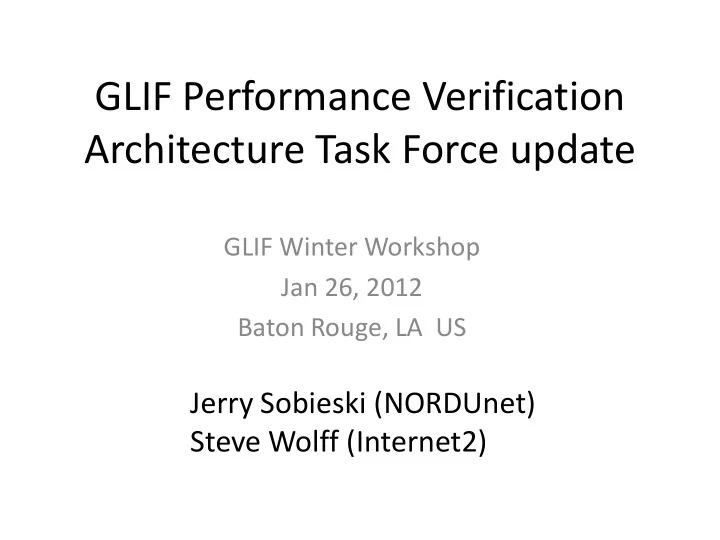

GLIF Performance Verification Architecture Task Force update GLIF Winter Workshop Jan 26, 2012 Baton Rouge, LA US Jerry Sobieski (NORDUnet) Steve Wolff (Internet2)
GLIF-PV Task Force Purpose • The GLIF PV Task Force is a greenfield effort to define an architecture for end to end verification of light path services, and a strategy for automated fault localization, mitigation, and recovery – Secure, scalable, “industrial strength” – Leverage the emerging NSI Framework • This group is developing recommendations, not standards. – A report/white paper will be the result – Target: 12 months. • GLIF PV TF Charter: http://www.glif.is/working-groups/tech/glif- pv-task-force-charter.pdf
Task Force Management • Co-Chairs: – Jerry Sobieski (Dir., Int’l Research Initiatives, NORDUnet) – Steve Wolff (CTO, Internet2) • Conference Calls: • Trying to find/set regular weekly schedule • Discussion: – Mailing List: glif-pv@glif.is (currently ~15 folks) – Subscribe at: http://www.terena.org/mailinglists.php?list=glif-pv@glif.is •
The Big Idea A Aruba Curacao Z Bonaire Given the NSI style scenario above… • How do we describe it? What are the fundamental objects and how do we • define them in a technology agnostic and service independent fashion? How do we determine the path? How do we test the path? How do we • evaluate the results? What “constructs” are necessary to define a generalized model for PV? How do we detect and identify a failing segment? How do we mitigate such • failures? How do we do so with automated agents rather than email, jabber, telephone calls, and human-in-the-loop processes? How do we insure the security and privacy of both the network and the • service instance? How do we insure the system is robust and does not itself fail? How do we apply this to emerging multi-layer virtualized service • infrastructure in a scalable and industrial strength manner?
Charter The GLIF End-to-End Performance Verification Architectures task force is chartered to develop recommendations for a deterministic, scalable, and secure architecture for determining the delivered end to end performance characteristics of emerging light path (connection oriented) network services. The Task Force should consider the OGF NSI Framework as the basis for the delivery of these light path services and so the resulting recommendations should support and complement the NSI Framework and may influence that Framework where appropriate. The E2E PVA recommendations may address any/all aspects of service delivery that will affect the predictable, deterministic, and scalable verification of light path performance. This includes but is not limited to service definitions/specifications, provisioning and/or control plane issues, formal methods for modeling (i.e. predicting) and manipulating such services, verification algorithms, formal methods for fault localization, and security and privacy of services, service domains, and the information gathered as part of this process. Verification of service performance should be considered for all aspects of the light path life-cycle- i.e. during selection and allocation of resources, during initial provisioning, and continuously during the active use of the service. The Task Force should view this as a green field opportunity and not feel compelled to define an architecture that is backward compatible with any existing networks or tool sets. It is of greater importance for the TF to develop a well considered, long term, and comprehensive future facing architecture that will bring greater predictability and reliability to these emerging light path services . To this end, experience with such tool sets and processes will be a valued asset in the discussions.
Future Forward The GLIF Performance Verification TF is trying to define the • environment we wish to have 5+ years down the road: – Secure (!) – Widely deployed dynamic connection/light path services – Global interoperability across heterogeneous networks and services – Beyond R&E – a model/environment that enables commercial adoption and interoperability – Virtual network services and infrastructures – Multi-layer infrastructure and services – Automated - fast, deterministic, predictable, and reliable function, etc. Use to-date experience to inform future design. • A trajectory that allows time to identify issues and design the • architecture; prototype, refine, standardize, mature; and deploy the service capabilities in real networks… Join the list, join the discussion… • Thanks!
Recommend
More recommend